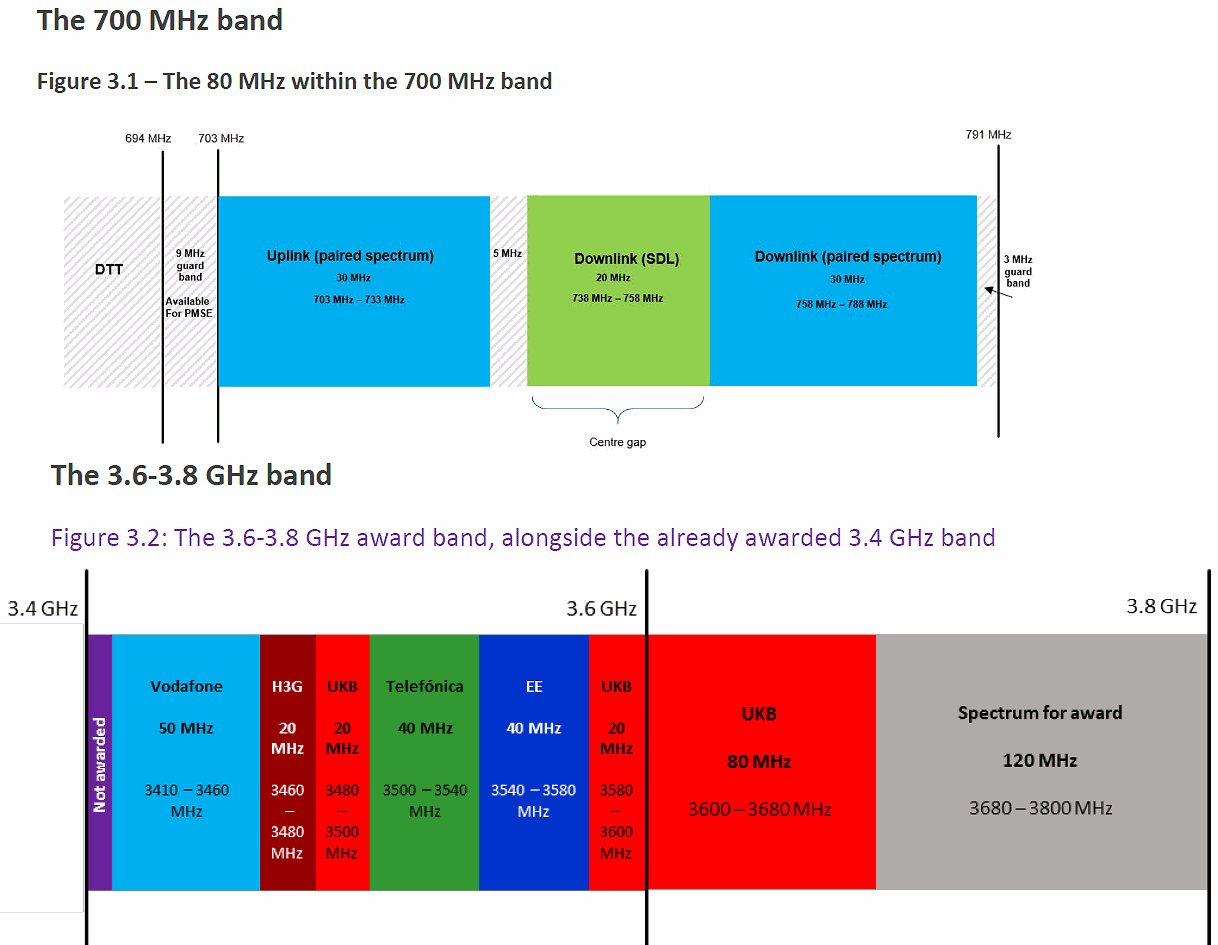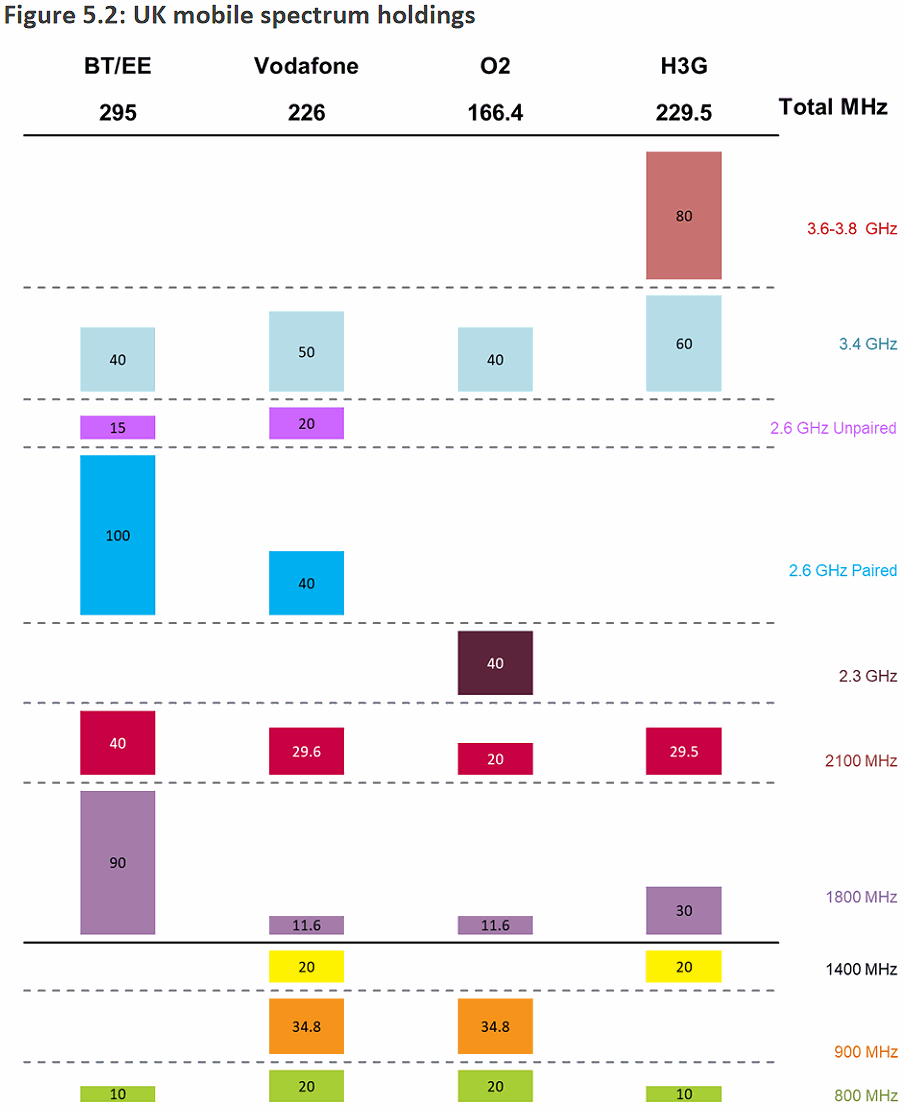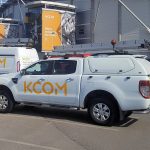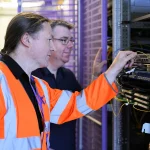Ofcom Consult on UK Mobile Spectrum Sharing and 5G Auctions UPDATE
The UK telecoms regulator has moved to improve 4G and future 5G mobile coverage by setting out their plans for “spectrum sharing” in the 1800MHz, 2300MHz and 3.8-4.2GHz bands, as well as finalising new coverage obligations for next year’s auction of the 700MHz band. The 3.6GHz – 3.8GHz bands will also be auctioned.
As previously reported, Ofcom plans to auction off the 700MHz band (formerly used for Digital Terrestrial TV services) next year for use by future Mobile technologies (e.g. 5G). The lower frequency of this band makes it ideal for delivering wide geographic coverage (e.g. rural areas and voice services), not unlike the 800MHz band before it, although mobile broadband speeds will be limited by the amount of frequency (80MHz) available.
Crucially the regulator revealed earlier this year that the 700MHz band would also come attached to a new coverage obligation (details) and they’ve today published the final plan for this.
Advertisement
The 700MHz Coverage Obligation
The binding coverage rules mean that up to two winning bidders would each have to, within 4 years of the award:
1. Extend good, outdoor data coverage to at least 90% of the UK’s entire land area within four years of the award.
2. Improve coverage for at least 140,000 homes and offices which they do not already cover. This means new coverage will be targeted at areas that are harder to reach; and
3. Provide coverage from at least 500 new mobile mast stations in rural areas. This will ensure operators transform coverage in areas where it is lacking, rather than meeting the rules by just boosting existing signals.
However Ofcom has recognised that it will take “significant investment” to meet the new obligations and so they’re proposing to offer the two coverage obligations as “coverage lots” alongside and separate from spectrum lots in the auction. Each coverage lot would carry an associated discount, up to a maximum set by Ofcom, on the price of spectrum (i.e. a maximum discount in the range £300m-£400m for each obligation).
In addition, the regulator proposed that “mutually agreed roaming arrangements onto a host network” should also be allowed to count towards fulfilment of these coverage obligations, at least “provided the service onto which the obligated operator roams meets the obligation requirements.”
At the same time (i.e. part of the same auction) Ofcom said they will also auction off 120MHz of frequency in the 3.6GHz – 3.8GHz bands, which will be useful for delivering ultrafast 5G based mobile and fixed wireless broadband services in urban areas. As part of this they intend to impose a cap of 416MHz (37% of the total) on the cumulative spectrum for mobile services held by any winner in the auction.
This would effectively limit the spectrum which some operators could acquire in the award, and would mean, for example, that EE (BT), the operator with the largest current spectrum holdings, would not be allowed to win more than 120MHz of spectrum in this award. In the past such situations have resulted in auction delays due to legal challenges.
Advertisement

Ofcom said that they expected to start this auction either during early or late 2019, which suggests that they’re expecting to have to fend off some frustrations from a few of the main mobile operators. The regulator is now inviting responses to their related consultation, which will close on 12th March 2019, and at present they’re “aiming to conduct the auction” by Spring 2020.
Philip Marnick, Ofcom’s Spectrum Group Director, said:
“Mobile coverage has improved across the UK this year, but too many people and businesses are still struggling for a signal. We’re particularly concerned about mobile reception in rural areas.
As we release new airwaves for mobile, we’re planning rules that would extend good mobile coverage to where it’s needed. That will help ensure that rural communities have the kind of mobile coverage that people expect in towns and cities, reducing the digital divide.”
Mark Bridgeman, CLA Deputy President, said:
“It has long been clear that mobile network operators will not invest sufficiently in improving coverage in rural areas unless they are compelled to do so. Today Ofcom has shown that it is serious about ending the digital divide that has disadvantaged rural businesses and communities for far too long. We will keep working to ensure people living and working in the countryside benefit from these new plans as swiftly as possible.
Progress in rolling out 4G to the countryside has been painfully slow but Ofcom’s changes to the 700Mhz spectrum auction set out a path for the genuine and significant improvements that are so crucial to unlocking the potential of the countryside. This is more important now than ever, as rural businesses prepare for the challenges and opportunities of Brexit.
The new measures also open the way for a rural roaming approach, where mobile network operators can arrange for their customers to switch between networks to help improve coverage. We look forward to hearing from the operators how they can make the best use of this opportunity.”
Assuming all goes well, which it often doesn’t, then the 700MHz band would become available for use by May or June 2020 and it’s a similar story for the 3.6-3.8GHz bands, although on the latter they warned that “some localised constraints” may remain in place until the end of 2022.
Spectrum Sharing
On top of all this the regulator has also published plans to allow certain spectrum to be shared by different users, to support innovation and local coverage initiatives across the UK economy (here). This includes proposals to make spectrum available for shared use in the 1800MHz and 2300MHz bands, which can be used by existing mobile handsets.
Advertisement
“This spectrum could support deployment of local networks in sectors including industrial Internet of Things (IoT), enterprise, logistics, mining and agriculture, as well as help to improve the quality of coverage in poorly served areas,” said Ofcom. They also plan to enable third parties to use airwaves that are licensed to mobile operators, but not being used by them (i.e. suitable for local communities to boost coverage).
Ofcom Statement
In order to ensure users have access to suitable spectrum to meet their needs, we propose to:
1. Enable them to access a number of spectrum bands, which support mobile technology, in locations unused by other licensed users. These are: 3.8-4.2 GHz, the 1800MHz shared spectrum and the 2300MHz shared spectrum (“the three shared access bands”).
Potential users would be able to make a simple request to Ofcom specifying the bands and the locations in which they wish to operate. To achieve a simple process applicable across the three shared access bands, we are also proposing to change the current authorisation approach in the 1800MHz shared spectrum from “self managed” to “Ofcom managed”; and
2. Facilitate access, through engagement with incumbent licensees, to awarded mobile spectrum covered by the Mobile Trading Regulations. These are currently the 800MHz, 900MHz, 1400MHz, 1800MHz, 1900MHz, 2100MHz, 2.3GHz, 2.6GHz and 3.4GHz bands.
Doing all this will be easier for some bands than others and it will be interesting to see how some of the existing holders of that spectrum react. Under this system companies will apply to Ofcom for a licence for a specific location. For each licence application, the regulator will assess interference with regards to and from other licensees in the band, based on our proposed coordination parameters and methodology.
Assignments will be made on a first come, first served basis with regards to other users in the band (both new and incumbent). “This will provide a simple way for users to access spectrum where they need it, with a choice of bands to suit their needs and with certainty in spectrum access and quality of service,” said Ofcom.
Ofcom intends to publish a statement on all this in Q2 2019 to confirm their plans and after that they intend to make new licences available in the second half of 2019. Two kinds of licences have been proposed for this, a low-power local licence with a range of 50m for premises and a medium-power band for rural notspots.
UPDATE 4:04pm
Added a comment from the CLA landowners’ organisation above.
UPDATE 19th Dec 2018
Added the latest table of mobile spectrum holdings, so you can see which operator owns how much of any given band.

Mark is a professional technology writer, IT consultant and computer engineer from Dorset (England), he also founded ISPreview in 1999 and enjoys analysing the latest telecoms and broadband developments. Find me on X (Twitter), Mastodon, Facebook, BlueSky, Threads.net and Linkedin.
« 2018 Infrastructure Report Shows State of UK Broadband and Mobile
2018 ICMR Compares UK Broadband and Mobile to 17 Countries »

















































Comments are closed